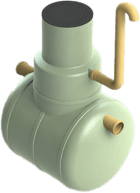
Our product range includes a sand mud trap, a class I oil trap, a class II oil trap and a grease trap.
All the traps are made of glass fibre reinforced plastic using the scroll method. Available diameters are 1200mm, 1600mm, 2100mm and 2400mm.
Our product range includes a sand-mud trap, a class I oil trap, a class II oil trap and a grease trap.
All catchers are made of fiberglass using the winding method. The offered diameters are 1100mm, 1200mm, 1500mm, 1600mm, 2100mm and 2400mm
The places of use of oil and gasoline traps are: parking lots, car washes, repair shops. Class I oil traps use the coalescence method and an additional filter system. This ensures that the content of hydrocarbons in the treated waste water is below 5 mg/l. Wastewater treatment in an oil trap begins with the separation of sand and mud in a sand and mud trap, which is built inside the oil trap or installed separately in front of the oil trap. After the oil trap, sampling wells are installed, which are equipped with a valve armature. At the customer’s request, the trap can also be equipped with an alarm system that gives a sound and light signal when the oil layer in the water reaches the maximum permissible thickness.
Bypass oil trap is used when the trap must have a high nominal capacity. For example, oily rainwater is collected from very large areas such as terminals, warehouses, highways, parking lots. In order to reduce acquisition costs, an oil trap with bypass is ideal for such conditions.
Class II oil traps are used in the management of rainwater and industrial wastewater into the sewage network. The main places of use are parking lots, terminals, industrial plants, driveways, car washes, repair shops, warehouses.